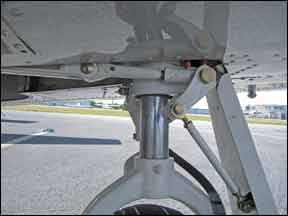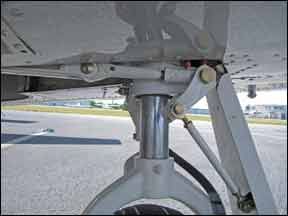In-flight emergencies are rare in the typical personal aircraft; the machines we fly are not all that complicated and theres not much to go wrong. While our primary training covered many contingencies, type-specific knowledge gained through a rental checkout, perusing the POH/AFM and dual instruction from someone with intimate knowledge of the machine-along with the emergency procedures 288 checklist-should get us through all but the most extraordinary problems. Not everything we might encounter aloft can be anticipated and practiced, however. For instance, we never know how well handle an in-flight emergency until we have one for real. We also wont know if the failure mode will allow the specified procedures to work until we try them. As I recently learned the hard way one dark, rainy night over south Florida, as long as we keep our cool, use the checklists and fly the airplane, well be fine. Routine Beginnings I was solo on an early evening mission in our Piper Comanche 250, from Pompano on Floridas east coast to Fort Myers Page Field on the west one, a route I fly every couple of weeks. Thunderstorms were brewing in the middle of the state, flowing to the northwest, so I flew a southern route to Naples, along the Interstate highway known as Alligator Alley, then turned to go up the coast. I didnt file IFR but obtained flight-following, since flying in rain and build-ups is not my preference but usually is the routing if you file. Flying up the coast past Southwest Florida International Airport (RSW), which is south of the Fort Myers Page Field Airport (FMY), it became apparent convective activity was overpowering the sea breeze and heading toward the coast. I still would be landing with plenty of miles between me and the storms. I turned inland and headed northeast toward the field, made my call to Page tower and established myself on downwind. I moved the gear switch down and moved my hand down to follow the gear handle. There was the sound of the gear motor, but nothing else. No lights, no gear handle moving, nothing. No matter, I thought; Ive done this plenty of times before, both for practice and for real. I called the tower controller, told him I had a problem and made a turn back to the coast to orbit and sort this out. Troubleshooting I kept contact with the tower but could not get the gear to come down. Its ordinarily a simple process-slow down, disconnect the landing gear from the gear motor assembly and use a handle to push the gear down using the same mechanisms the motor uses. Its simple and its easy if you are going slow (below 100 mph). But it wasnt working this night. The autopilot comes in real handy at times like this: I wont fall out of the sky while Im working on “issues.” I slowed down, I turned, I sped up. I pushed on the handle with arms and a foot. Still nothing. Time passed, fuel burned and weather deteriorated behind me. I talked to the controller and passed along contact information for a friend and former owner of the airplane, but we could not come up with a reason why the manual extension wouldnt work or how to get the gear down. I was coming to grips with the situation and knew I had to make a decision to go somewhere, so after consulting about where the weather was, it was recommended I go back to the east coast. Acceptance I was switched back to the controller at Fort Myers International who helped me get around the weather, which was now north of them. It was the saddest time Ive ever spent in an airplane since I knew I had no choice but to land with the gear up-not an easy pill to swallow. Flying east for 10 minutes or so, I started weighing the choices between my home airport (no emergency services) and Fort Lauderdale Executive (lots of services) and I was leaning toward the no-services option, so why not divert to Sebring, my mechanics airport? It would be a very lonely place to belly in at 9:00 on a Friday night but the airplane would be where she needed to be for repairs. It seemed I had gone through the several stages of grief and was fully accepting the forthcoming gear-up landing. I asked the controller to check the weather between me and Sebring and he said it looked clear. He vectored me northeast and started asking me questions: “Do you have an emergency checklist?” “Yes.” Of course. “Have you followed the steps?” “Yes.” Duh. “Did you try the pump?” “There is no pump.” “Did you try the crank?” “There is no crank.” “Did you try diving?” Huh? “No. Ill try that. Itll take me a few minutes to climb.” I climbed above 4000, paused, then pushed the nose over. “This is never going to work” was my immediate thought since now my airspeed was high and there is no way to push the gear lever forward when the airspeed is high. I pushed anyway and realized I wanted to do just the opposite of diving and pulling out. What might help was to unload the drag, so I pulled the stick back, zoomed back up and slowed way down, all the while pushing with both feet, an obviously uncoordinated effort. The gear dropped down, locked and the green light glowed. The pilot beamed. Relief I told the controller I would like to land at Page or his airport, wherever the weather would permit. Page was still IFR so he turned me back to RSW. He turned the lights up to “Las Vegas Strip” intensity, but there were clouds between me and the airport for a short time. I loaded the RNAV approach for comfort and validation I was going in the right direction, then flew the glideslope and PAPI down to the runway. My landing was very, very tentative. The controller mentioned there would be flashing lights from the emergency vehicles. He was right-there were lots of them. Exactly two hours had passed since I started the engine at Pompano. I rolled to the taxiway, exited the runway and was totally mesmerized by the lights, exacerbated by the rain. Three times I had to ask for help getting to the ramp, I was so afraid I was going the wrong way while still mentally overloaded. (Green lights in the taxiways? Havent seen those lately.) The tower finally sent a “follow-me” Suburban to lead me to the ramp. So much for my navigation skills. But I was on the ground, my airplane was still intact and Id added another significant on-the-job lesson to my collection. Post-Mortem Over the course of a mostly sleepless night, I reviewed the several lessons I learned. Time and fuel were both on my side, so what was my hurry? I felt like a coward to have accepted the fate of a gear-up landing when I wasnt really out of options or ideas-I only thought I was. Dealing with the issue in the air had been tiring, so a sliver of “get-there-itis” had factored into my decision: I had my destination picked so “lets get this over with.” In fact, the controller asking me questions had become borderline annoying, but because he persisted, I was able to not dwell on what I thought was the inevitable. He was just doing his job, I now realize, and Im grateful. With the benefit of hindsight, continuing to perform a task I thought was sure to fail turned out to be the most beneficial decision of all. The next morning, after an inspection was performed on the ground, I flew gear-down to Sebring, where Id leave her for maintenance and a slightly early annual. No obvious cause of the problem of the previous night could be seen-nothing was broken, scraped or otherwise out of place. Then I got the call from the mechanic. Diagnosis A month earlier, we had flown the airplane to Oshkosh for that years EAA AirVenture. The grounds were wet and there was a great deal of taxiing to park the plane for the day. As is the case with long cross-country trips, there wasnt an opportunity for me to wash the plane during the trip so, after starting our trip back down south, we stopped for an overnight and I asked for a recommendation of someone to wash the plane. Im typically the washer, so this was all new to me. I met with the gentleman the next morning to review the job. I noticed he had a pressure washer and I told him I had heard these shouldnt be used on the gear but he assured me he would use it on the oily belly of the airplane and lightly on the tires. When he was done, the airplane sat for a day to dry and the mechanic lubed the gear. Our pre-flight the next day included looking at the gear, wheel wells and belly just a little more closely than normal. All of the Zerk fittings were lubed and had fresh grease visible. Now back to that phone call. My mechanic Florida put the airplane on jacks, reattached the gear motor assembly and attempted to raise the gear. There was lots of noise from the main gear doors. The lubricant was totally gone from the rod-end bearings and they were frozen. As soon as the doors were disconnected, the gear worked as it should. As part of the inspection they disassembled the wheels. Water poured from the axles, and the bearings were grease-free and rusted. A little more time baking in the harsh Florida climate could have led to a very exciting landing. The one I had was exciting enough, thank you very much. Lessons The lessons here are different for every pilot and every aircraft. Closely monitoring how and by whom your aircraft is maintained is an obvious one, as is ensuring only manufacturers recommended practices are employed. Another one is knowing the aircrafts systems, and practicing various emergency procedures every now and then, including but not limited to the landing gear extension procedures. One of the most difficult and important lessons I learned is the need to keep a cool head while dealing with an in-flight emergency. Having the aforementioned practice with various emergency procedures-knowing the procedural sequence, for example, or having flown the airplane at the recommended speed and configuration for an emergency gear extension while running the checklist-helps give one the confidence needed to accomplish all these tasks when the chips are down. Experience always helps, even if its only practice. While airborne and dealing with this issue, I admitted to those I spoke with on the ground that I was scared. But I also said, more than once, out loud and to myself, “fly the airplane,” which was my true direction finder. Sue Folkringa is an instrument-, multi-engine- and seaplane-rated commercial pilot with more than 1300 hours of experience.




